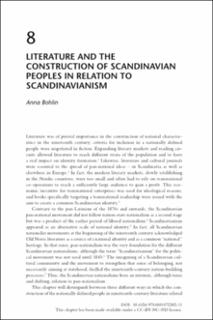Literature and the Construction of Scandinavian Peoples in Relation to Scandinavianism
Chapter, Peer reviewed
Published version

Åpne
Permanent lenke
https://hdl.handle.net/11250/3073157Utgivelsesdato
2023Metadata
Vis full innførselSamlinger
Originalversjon
In: Hemstad, R. and Stadius, P. (eds.), Nordic experiences in pan-nationalisms: a reappraisal and comparison, 1840–1940, pp. 139-157. https://doi.org/10.4324/9781003372202-11Sammendrag
Literature was essential to the spread of pan-national ideas – in Scandinavia as well as in pan-national movements elsewhere in Europe. Contrary to some pan-national movements that represented a stage following nation-state nationalism, Scandinavianism was promoted as an alternative scale of national identity. In fact, since all Scandinavian nationalist movements at the beginning of the nineteenth century acknowledged Old Norse literature as a source of a national identity and as a common “national” heritage, the Scandinavian peoples were construed in a tense and shifting relation to pan-national ideas to begin with.
This chapter identifies three different relations to a Scandinavian cultural community in constructing nationally defined peoples: explicit, dismissed or unacknowledged. The examples are drawn from mid-nineteenth-century literature by the Finnish J.L. Runeberg, the Danish Mathilde Fibiger, the Norwegians Camilla Collett, Henrik Wergeland and J.S. Welhaven, and the Swedes Fredrika Bremer and C.J.L. Almqvist. Three themes are focused: women's emancipation, the re-use of Old Norse myth and poverty as a national characteristic.
